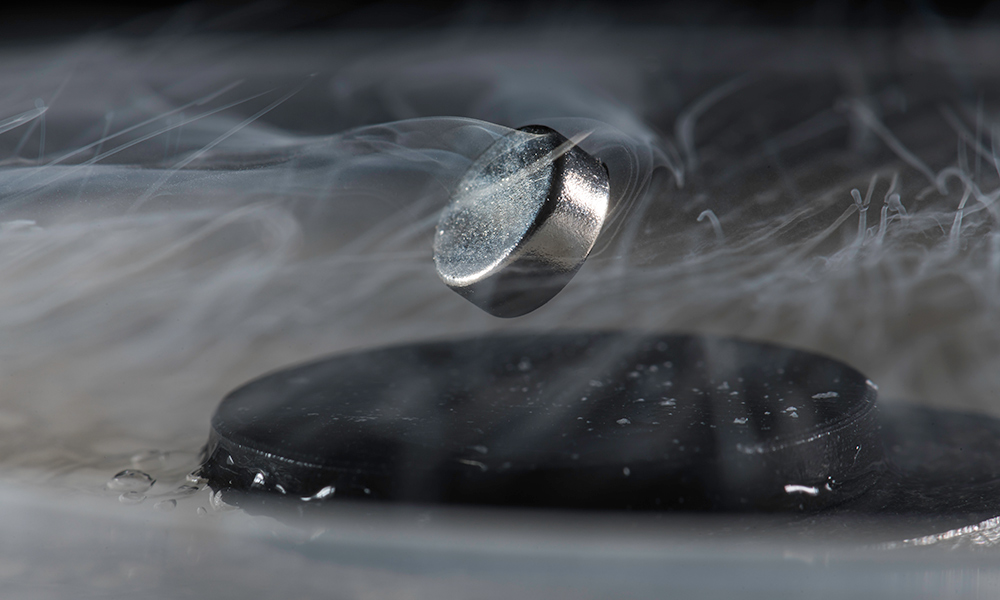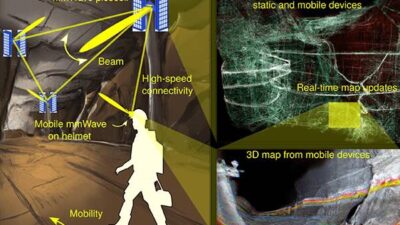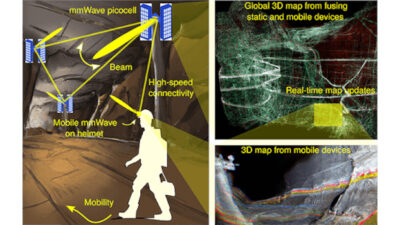A new record for the temperature at which materials have superconductivity and has developed a novel way to synthesize superconducting materials at lower pressures than previously reported. See video.

Compressing simple molecular solids with hydrogen at extremely high pressures, engineers and physicists are setting new records in the race for materials that are superconducting at room temperature. The lab of Ranga Dias, an assistant professor of mechanical engineering and of physics and astronomy at the University of Rochester, has reported a new record for the temperature at which materials have superconductivity and has developed a novel way to synthesize superconducting materials at lower pressures than previously reported.
Dias says developing materials that are superconducting—without electrical resistance and expulsion of magnetic field at room temperature—is the “holy grail” of condensed matter physics. Sought for more than a century, such materials “can definitely change the world as we know it,” Dias says.
In a report featured as the cover article in the journal Nature (and as part of the Nature Podcast), Dias and his research team combined hydrogen with carbon and sulfur to photochemically synthesize simple organic-derived carbonaceous sulfur hydride in a diamond anvil cell, a research device used to examine miniscule amounts of materials under extraordinarily high pressure.
The result was a new record: a material that exhibited superconductivity at about 58 degrees Fahrenheit and a pressure of about 39 million pounds per square inch (psi).
In a second study published in Physical Review Letters, the lab described separating hydrogen atoms from yttrium with a thin film of palladium. The resulting yttrium superhydride is superconducting at 12 degrees Fahrenheit and about 26 million pounds per square inch. (Pressure at sea level is about 15 psi.)
While that pressure is still too high for practical applications, the new material is a significant improvement over the room temperature superconducting materials the researchers reported last fall in Nature. And both results demonstrate progress toward eventually creating a room temperature superconductor.
“We will continue to use this new method to synthesize new superconducting materials at ambient pressure,” Dias says.
Dias, who is also affiliated with the University’s materials science and high-energy-density physics programs, says if the extraordinary properties of superconductivity could be made more practical, such materials would open the door to many potential applications.
Applications include:
- Power grids that transmit electricity without the loss of up to 200 million megawatt hours (MWh) of the energy that now occurs due to resistance in the wires
- A new way to propel levitated trains and other forms of transportation
- Medical imaging and scanning techniques such as MRI and magnetocardiography
- Faster, more efficient electronics for digital logic and memory device technology.
The amount of superconducting material created by the diamond anvil cells is measured in picoliters—about the size of a single inkjet particle. The next challenge, Dias says, is finding ways to create the room temperature superconducting materials at lower pressures, so they will be economical to produce in greater volume.

Why room temperature matters for superconductivity
First discovered in 1911, superconductivity gives materials two key properties. Electrical resistance vanishes. And any semblance of a magnetic field is expelled, due to a phenomenon called the Meissner effect. The magnetic field lines have to pass around the superconducting material, making it possible to levitate such materials, something that could be used for frictionless high-speed trains, known as maglev trains.
Powerful superconducting electromagnets are already critical components of maglev trains, magnetic resonance imaging (MRI) and nuclear magnetic resonance (NMR) machines, particle accelerators and other advanced technologies, including early quantum supercomputers.
But the superconducting materials used in the devices usually work only at extremely low temperatures—lower than any natural temperatures on Earth. This restriction makes them costly to maintain—and too costly to extend to other potential applications. “The cost to keep these materials at cryogenic temperatures is so high you can’t really get the full benefit of them,” Dias says.
Previously, the highest temperature for a superconducting material was achieved last year in the lab of Mikhail Eremets at the Max Planck Institute for Chemistry in Mainz, Germany, and the Russell Hemley group at the University of Illinois at Chicago. That team reported superconductivity at -10 to 8 degrees Fahrenheit using lanthanum superhydride.
Researchers have also explored copper oxides and iron-based chemicals as potential candidates for high temperature superconductors in recent years. However, hydrogen—the most abundant element in the universe—also offers a promising building block.
“To have a high temperature superconductor, you want stronger bonds and light elements. Those are the two very basic criteria,” Dias says. “Hydrogen is the lightest material, and the hydrogen bond is one of the strongest.
“Solid metallic hydrogen is theorized to have high Debye temperature and strong electron-phonon coupling that is necessary for room temperature superconductivity,” Dias says.
However, extraordinarily high pressures are needed just to get pure hydrogen into a metallic state, which first achieved in a lab in 2017 by Harvard University professor Isaac Silvera and Dias, then a postdoc in Silvera’s lab.
A ‘paradigm shift’ for superconductors
And so, Dias’s lab at Rochester has pursued a “paradigm shift” in its approach, using as an alternative, hydrogen-rich materials that mimic the elusive superconducting phase of pure hydrogen, and can be metalized at much lower pressures.
Coauthors on the papers include lead author Elliot Snider ’19 (MS), Nathan Dasenbrock-Gammon ’18 (MA), Raymond McBride ’20 (MS), Kevin Vencatasamy ’21, and Hiranya Vindana (MS), all of the Dias lab; Mathew Debessai of Intel Corporation, and Keith Lawlor and Ashkan Salamat of the University of Nevada Las Vegas.
The project was supported with funding from the National Science Foundation and the US Department of Energy’s Stockpile Stewardship Academic Alliance Program and its Office of Science, Fusion Energy Sciences. Preparation of the diamond surfaces was performed in part at the University of Rochester Integrated Nanosystems Center (URnano).
– Edited by Chris Vavra, web content manager, Control Engineering, CFE Media and Technology, [email protected].



